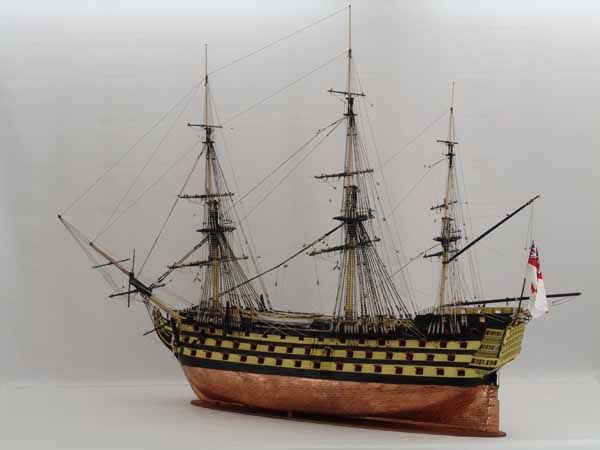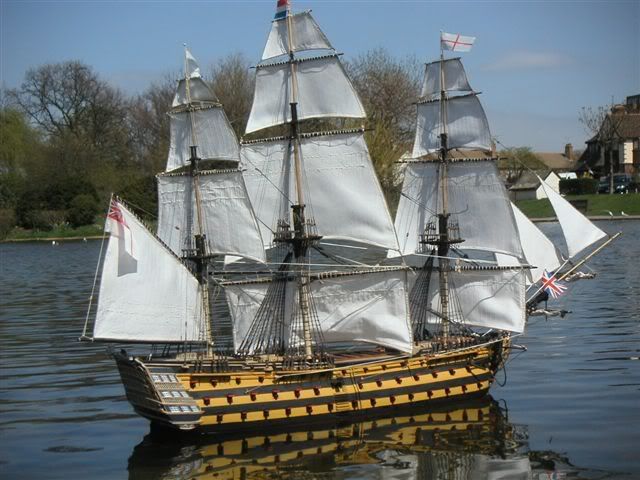It is a great idea especially if they would include enough cannons to adorn the openings for each added section kit! Would you recommend using some type of silicone sealer on the addition joints to make the ship water worthy? How far below the water line would the bottom of the ship need to extend to prevent water from entering the gun ports due to the present problem of shallow hulls taking in water in the current PM designs? I have another question concerning creating a ship of this enormous size regarding balance on water,...how much ballast would you estimate it would need to stay upright, fully manned & equipped  ? Sorry for so many questions, but this idea intrigues me
? Sorry for so many questions, but this idea intrigues me  !
!
Well, on a larger multi-decked ship like the Victory, you can see here that almost HALF the entire hull is below the waterline!


But even on a correctly-portioned scale model (sailable) ship like the one in the above pic, I have seen the lowest cannon ports delve below the waterline in rough waters; even if the ship (even a playmoship) is scaled correctly with correct ballast and everything, one thing will always be out of scale: WAVES. Real life waves don't shrink down to accommodate our miniature ships! Even when scaled correctly, this still puts our cannon ports only an inch or two above the waterline in real life. So, much like the model above, the cannon ports, while they may still brandish cannons, will have to somehow be sealed off from the hull because they ARE going to delve below the waterline at some point, unless you're just sailing your ship in a still pond/bathtub.
On my Black Pearl, I find when fully loaded with all cannons and personnel, along with enough ballast to counter the extra topend weight, it also follows this rule, where a little less than half the ship's hull is below the waterline (bringing the cannon ports way too close to the water.)
So, IMO, maybe there would have to be additional hull-bottom add-ons (or make the base hull bottom deep to begin with) to counter extra decks being stacked. In short, every time you add an extra deck, you have to have that much more "bottom" thickness" to the hull to compensate. So when you build up, you also have to build down.
However, if you're simply trying to increase the length of the ship by adding single hull units (and not stacking decks), it shouldn't need any extra compensation other than additional ballast which should already be incorporated in each individual hull unit.
As far as sealant between compartments, my thoughts was that the compartments would be self-contained, at least on the bottom portions that fall below the waterline. (each piece could float on it's own). Technically, if assembled with multiple units, water could still get in between the units, but won't leak INTO the units. Essentially, the units below the waterline will have walls that are sealed off completely from the other units. this is actually an innovation that real ships would later employ: compartamentalized hull sections. In real life this allowed ships to purposely flood specific compartments to adjust ballast according to the ship's current load. Also, for fishing vessels, it allowed parts of the hull to be filled with water to take on live catch. More importantly, compartamentalized hull sections were safer, in case the hull was breached, only that specific part of the hull would take on water instead of the entire ship, thus saving the ship from sinking completely.
In my vision, the hull sections would join firmly together via some sort of male-female system (I doubt system x would be strong enough).
The portions above the water line wouldn't have to have sealed off walls. They'd still have walls, but there will be doors/passageways connecting the decks so the klickies can still walk the length of the ship on each deck.
I'll have to draw this up with pencil or mouse tablet later, as drawing with MS Paint line tool is tedious.
I know this'll probably never happen, but this is our wishful thinking thread, is it not?
